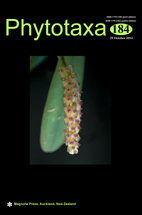Abstract
Mastigolejeunea (Spruce 1884: 100) Stephani (1889: 257) is a pantropical genus with 16 extant species (Sukkharak & Gradstein 2014a). The centre of diversity is Southeast Asia with 10 species occurring in the region. This genus is very similar to Thysananthus Lindenb. in Lehmann (1844: 24) and the two genera can be separated by the presence of an entire perianth in Mastigolejeunea and toothed in Thysananthus (Sukkharak 2014; Sukkharak & Gradstein 2014a). Three species, M. humilis (Gottsche in Gottsche et al. 1845: 299) Schiffner (1893: 129), M. indica Stephani (1912: 776) and M. repleta (Taylor 1846: 392) Evans (1902: 131), have so far been reported in China (He 1997; Mizutani 1986; Piippo 1990). In the course of our studies on Chinese Ptychanthoideae Mizutani (1961: 146), we found a new record of M. virens (Ångström 1873: 131) Stephani (1912: 776) for the ptychanthoid flora of China. Mastigolejeunea virens has been reported from Australia, Indomalesia, Seychelles and the tropical Pacific region (Sukkharak & Gradstein 2014a). We report the species here for Hainan, China, which is its northernmost locality. In addition, we newly report the occurrence of asymmetrical underleaves associated with left-right symmetry in M. virens based on our study of specimens collected in China and Thailand.

